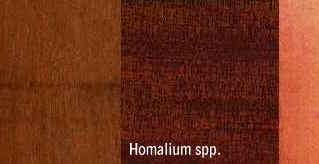
Burma lancewood (Homalium spp.)
Family: Flacourtiaceae
Common names: Bro kpah, Burma lancewood, Malas, Melefoufou, Myauk chaw, Myaukugo, Petaling padang, Puyot, Selimbar
Distributed in: Malaysia, Myanmar, Philippines (Oceania and S.E. Asia)
Distribution overview: Burma to Indomalesia. A tree of primary, lowland, rain forest found between 50 - 600m.
Common uses: Balusters, Bent Parts, Building materials, Cabinetmaking, Ceiling, Chairs, Chests, Desks, Dining-room furniture, Domestic flooring, Drawer sides, Exterior trim & siding, Exterior uses, Fine furniture, Flooring, Furniture , Furniture components, Furniture squares or stock, Handles, Hatracks, Interior construction, Kitchen cabinets, Living-room suites, Millwork, Office furniture, Parquet flooring, Radio - stereo - TV cabinets, Rustic furniture, Shafts/Handles, Shakes, Sheathing, Shingles, Siding, Stairrails, Stairworks, Stools, Stringers, Sub-flooring, Tool handles, Turnery, Utility furniture
Environment profile: Status has not been officially assessed
Tree size: Trunk diameter is 100-150 cm
Colors: the heart isWhite, Yellowand the sapwoodWhite, Yellow.The grain isStraight, the textureMediumand the lusterDull
Natural durability: Non-resistant to termites, Susceptible to insect attack
Odor: No specific smell or taste
Some Homalium species are reported to have an iodine-like scent that may persist for a long time
Kiln Drying Rate: Naturally dries slowly
Drying Defects: Severe end splitting, Severe surface checking
Ease of Drying: Slowly
Comments: May contain crystals
Blunting Effect: Severe
Boring: Fairly easy to very easy
Carving: Generally good results
Cutting Resistance: Difficult to saw
Gluing: Fairly Easy to Very Easy
Mortising: Fair to Good
Moulding: Fair to Good
Movement in Service: Fair to Good
Nailing: Fair to Good , Fairly Easy to Very Easy
Planing: Very Good to Excellent
Resistance to Impregnation: Sapwood is permeable
Response to hand tools: Fairly Difficult to Difficult to Work
Sanding: Good sanding qualities
Turning: Fairly Easy to Very Easy
Polishing: Good; Staining: Fair to Good;
- Numerical data Metric
- Numerical data English
- Strength properties
- References
 |
 |
 |
 |
| Item |
Green |
Dry |
Metric |
| Specific Gravity |
0,68 |
|
|
| Density |
|
913 |
kg/m3 |
| Bending Strength |
950 |
1203 |
kg/cm2 |
| Crushing Strength |
86 |
110 |
kg/cm2 |
| Hardness |
|
842 |
kg |
| Impact Strength |
|
|
cm |
| Shearing Strength |
|
|
kg/cm2 |
| Stiffness |
138 |
152 |
1000 kg/cm2 |
| Tangential Shrinkage |
|
|
% |
| Radial Shrinkage |
|
|
% |
| Weight |
|
|
kg/m3 |
| Maximum Load |
|
|
cm-kg/cm3 |
| Toughness |
|
154 |
cm-kg |
| Static Bending |
645 |
854 |
kg/cm2 |
|
 |  |  |  | | Item | Green | Dry | English | | Bending Strength | 13519 | 17123 | psi | | Crushing Strength | 1225 | 1573 | psi | | Density | | 57 | lbs/ft3 | | Hardness | | 1857 | lbs | | Maximum Crushing Strength | 7071 | 8457 | psi | | Static Bending | 9183 | 12152 | psi | | Stiffness | 1970 | 2169 | 1000 psi | | Toughness | | 134 | inch-lbs | | Specific Gravity | 0.68 | | | | Weight | 52 | 43. | lbs/ft3 | |
Bolza, E., Kloot, N. H. 1966. The Mechanical Properties of 81 New Guinea Timbers. Technological Paper No. 41. Division of Forest Products, Center for Scientific and Industrial Organization (CSIRO, Melbourne, Australia.Chudnoff, M.,1984,Tropical Timbers of the World,U.S.A. Department of Agriculture, Forest Service, Forest Products,Laboratory, Madison.EcoTimber International, San Francisco, California. Personal Communication, 1993.Keating, W.G., Bolza, E.,1982,Characteristics properties and uses of timbers. South East Asia, Northern,Australia and the Pacific,C.S.I.R.O. Div. Chemical Technology,Inkata Press,1Kloot, N. H. and E. Bolza.1961.Properties of Timbers Imported into Australia.Technological Paper No. 12.Division of Forest Products, Commonwealth Scientific & Industrial Research Organization, Melbourne, Australia.
|








